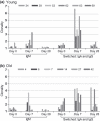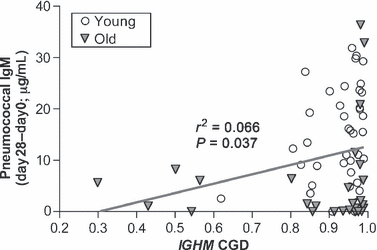Vaccination-induced changes in human B-cell repertoire and pneumococcal IgM and IgA antibody at different ages
- PMID: 21726404
- PMCID: PMC3264704
- DOI: 10.1111/j.1474-9726.2011.00732.x
Vaccination-induced changes in human B-cell repertoire and pneumococcal IgM and IgA antibody at different ages
Abstract
It is well known that older people are more susceptible to morbidity and mortality from infectious diseases, particularly from pulmonary diseases such as pneumococcal pneumonia where vaccines do not provide efficient protection as in younger populations. We have previously shown that the B-cell repertoire in the old is reduced and hypothesise that this may contribute to the impaired humoral responses of the elderly. Here, we investigated the repertoire and antibody responses to winter vaccination in two age groups, aged 18-49 and 65-89. We found that the serum IgM and IgA pneumococcal responses were significantly impaired in the older group, with no difference in IgG levels. IGHM spectratype analysis seems to be the most promising in terms of its predictive ability for vaccine responses. Spectratypes showed a clear change in the repertoire at day 7 after vaccination, with a return to the baseline levels at day 28. The changes at day 7 reflected expansion of IGH sequences that have smaller, more hydrophilic, CDR3 regions, and these changes were attenuated in the older group. The older group was more likely to have spectratypes indicative of a reduced diversity at day 0 and day 28. On average, the baseline repertoire in the older group was comprised of larger CDR3 regions than in the younger group. In conclusion, IgA and IgM responses are significantly impaired in the elderly pneumococcal response and are likely key mediators of protection. Hydrophilicity and/or small size of the IGH CDR3 appear to be important in these responses.
© 2011 The Authors. Aging Cell © 2011 Blackwell Publishing Ltd/Anatomical Society of Great Britain and Ireland.
Figures





References
-
- Banerjee M, Mehr R, Belelovsky A, Spencer J, Dunn-Walters DK. Age- and tissue-specific differences in human germinal center B cell selection revealed by analysis of IgVH gene hypermutation and lineage trees. Eur. J. Immunol. 2002;32:1947–1957. - PubMed
-
- Baxendale HE, Keating SM, Johnson M, Southern J, Miller E, Goldblatt D. The early kinetics of circulating pneumococcal-specific memory B cells following pneumococcal conjugate and plain polysaccharide vaccines in the elderly. Vaccine. 2010;28:4763–4770. - PubMed
Publication types
MeSH terms
Substances
LinkOut - more resources
Full Text Sources
Other Literature Sources
Medical
Miscellaneous

